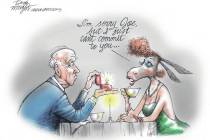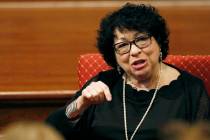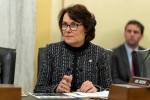Big help for Breeden, Copening
The dynamics of Nevada's 2012 legislative elections will change dramatically if new district maps, finally released last week, survive judicial reviews.
Republicans were in prime position to reclaim the state Senate next year. Democrats currently hold an 11-10 majority, but their two most vulnerable incumbents, Shirley Breeden and Allison Copening, are up for re-election in what are currently toss-up districts. The GOP needs to flip just one of those seats to take control of the upper chamber. The party plan: Go all in with strong candidates and big bucks and beat both women.
But the special masters put in charge of Nevada's redistricting process by District Judge James Todd Russell effectively built bunkers for the two sitting ducks.
Under its current boundaries, Breeden's Henderson district has almost even voter registration: 39 percent are Democrats, 38 percent are Republicans and 17 percent are nonpartisans, according to September figures from the secretary of state's office. The new boundaries are much friendlier to Breeden: 42 percent of voters are Democrats, 36 percent are Republicans and 17 percent are nonpartisans (I didn't include minor parties in my figures).
Copening, meanwhile, is in such political trouble she hasn't committed to seeking re-election. Like Breeden, she campaigned against tax increases in 2008, then voted for them in 2009 and 2011. And during the 2011 session, she was the poster girl for conflicts of interest, pushing heavy-handed legislation on behalf of homeowners associations while working for an HOA.
Her northwest Las Vegas district, as currently drawn, is 40 percent Democratic, 40 percent Republican and 15 percent nonpartisan. However, the special masters gave Copening the most favorable boundary revisions of any sitting senator, creating a district that's 44 percent Democratic, 35 percent Republican and 16 percent nonpartisan.
The state senator in need of the most help got the most help. Imagine that.
It won't be impossible for Republicans to win the seats held by Breeden and Copening next year. But it will be significantly more difficult if those new boundaries hold.
Russell, who took over the decennial process of redrawing Nevada's legislative and congressional districts when the Democrat-controlled Legislature gave up on striking a compromise with Republican Gov. Brian Sandoval, has scheduled a hearing for Thursday to determine whether to accept the special masters' maps, reject them or request revisions. Then, on Nov. 14, the Nevada Supreme Court will hold a hearing to decide whether Russell and his special masters have the authority to draw the maps in the first place, or whether the Legislature must fulfill its constitutional obligation to do the job.
The early Christmas presents for Breeden and Copening weren't the only slights handed to Nevada Republicans by the special masters. Democrats couldn't have fared much better if they drew the maps themselves.
The Senate district maps create nine "lock" districts for Democrats -- where registered Democrats outnumber registered Republicans by at least 15 percentage points -- and three districts that lean Democratic. That's 12 seats. That's a majority plus one.
Only two districts are locks for Republicans, with three seats leaning Republican and four seats rendered toss-ups, where the shares of registered Democrats and Republicans are within a single percentage point.
The new Assembly maps are just as bad for the GOP. Seventeen of the 42 districts are locks for Democrats and nine lean Democratic. Just four are locks for Republicans, seven lean Republican and five are toss-ups.
That Democrats would have an advantage in both houses is expected. Statewide, registered Democratic voters outnumber registered Republicans by more than 100,000 -- 43 percent of Nevada voters are Democrats, 35 percent are Republicans, 16 percent are nonpartisans and 6 percent are in other parties.
The new maps balance district populations almost perfectly, as required by law -- about 128,600 people per Senate district and 64,300 people per Assembly district. But in accomplishing that the special masters made more than half of the Legislature's 63 seats bulletproof. The outcomes of elections in those races are predetermined. That discourages engaged citizens who might otherwise be viable challengers to incumbents from ever seeking elected office. That allows incumbents to play to their party bases, and it cheats residents of those districts out of rigorous campaigns.
But giving three-quarters of those uncompetitive districts to Democrats is a disaster. It assures the party will remain a wholly owned subsidiary of public employee unions, hostile to business, opposed to major education reforms and hungry for tax hikes. And it creates the appearance of Democratic bias for the special masters.
In addition to the favorable boundaries for Breeden and Copening, the masters singled out a handful of Republican lawmakers for punishment.
Assemblyman Mark Sherwood, R-Henderson, was shifted from a district in which Republicans hold a 40 percent to 38 percent advantage into one that favors Democrats 42 percent to 35 percent, with 17 percent nonpartisan. Assemblyman Cresent Hardy, R-Mesquite, represents a district that is 48 percent Republican, 30 percent Democratic and 16 percent nonpartisan. His new district, as drawn, includes parts of eastern Las Vegas and has an even amount of registered Republicans and Democrats. Sen. Elizabeth Halseth, R-Las Vegas, won a tough election in 2010 in a district that's 40 percent Democratic, 37 percent Republican and 18 percent nonpartisan. Her new boundaries are even less favorable: 42 percent of the voters are Democrats, 33 percent are Republicans and 19 percent are nonpartisans.
Just one Republican lawmaker reaped huge rewards from the redrawing of the maps. Assemblywoman Melissa Woodbury, R-Las Vegas, who wins in Democratic district on the strength of her last name (her father, Bruce Woodbury, was a longtime county commissioner), saw her district flop from a 43-34 Democratic advantage to a 45-34 GOP edge. If Woodbury is going to win regardless of demographics, she might as well have a Republican district. That's what I'd think if I were a Democrat drawing the maps.
Just one Democratic lawmaker was dealt a lousy hand by the special masters. Freshman Assemblyman Steven Brooks, D-Las Vegas, was drawn out of a district that is 54 percent Democratic and 24 percent Republican into the toss-up district that includes the GOP's Hardy.
There will be no balance of power in the Legislature if these maps become law.
Glenn Cook (gcook@reviewjournal.com) is a Review-Journal editorial writer.























